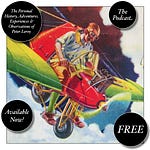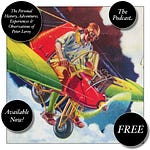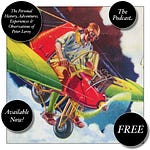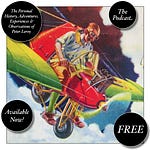8
THE READER COULD BE SURE, at the beginning of any Larry Peters book, that Larry would soon be up to something interesting, for Larry shared his father’s ingenuity for creating amusing diversions, devising interesting endeavors. Often, these were obviously derivative: after his father suggested building a raft to chart the Gulf Stream, Larry suggested casting adrift bottles containing questionnaires about the weather conditions and curious local customs of the areas in which they would eventually wash ashore; inspired by his father’s car-rocking idea, Larry developed the “dry land sailboat,” a dinghy on a platform decorated with a cardboard sea, which would fit within one half of a two-car garage and could be rocked by a near relative of the mechanism his father had designed to rock automobiles.
(The “dry land sailboat” was the basis for the subplot in The Thief of Time. In that book, Larry entertained hopes that he and Rocky might go into business for themselves with this device, but, sadly, their hopes were shattered when Harrison Whitehead, one of the world’s most distinguished brummagem designers, a mainstay of the Peters outfit, was killed during the testing of the prototype when the mock-up two-car garage filled with real exhaust fumes from the real car that Larry and Rocky and Lucinda had brought over from the mainland to drive the mechanism. The incident was reported in the Murky Bay Daily News under the headline, “Boating Accident Leaves One Dead.”)
Others of Larry’s projects were more original: his planting most of the island in bamboo and hacking out intricate pathways through it (in Bamboozled) remains my favorite, and I remember with fond admiration his success in persuading Lucinda and several of her pubescent friends to dye their hair auburn and participate in a tableau vivant based on John William Waterhouse’s Hylas and the Nymphs (in That Crazy Redhead).
In each of the Larry Peters adventures, the plot of the adventure itself turned somehow on the latest of Mr. Peters’s or Larry’s inventions, preoccupations, or avocations. For a reader who was familiar with the series and its conventions, one of the pleasures of reading any new volume came from trying to anticipate the way in which Larry’s current interest would figure in the resolution of the mystery, the capture of the crooks, the unmasking of the spies, the rescue of the hostages, or whatever other satisfactory resolution would conclude the story. Take, as an example, The Phantom Island, the eleventh novel in the series. In the first chapter, Larry assembles his family in the living room for the unveiling of a painting that he has executed on one of the living-room windows.
“Well, let’s have a look at it,” said Edgar Peters, with furrowed brow. He threw a protective arm across the shoulders of his wife, Antonia.
Larry arranged his family in a semicircle facing the draped window. Hector, an old mustard-colored dog, followed feebly after them, made his way to a spot just in front of the drapes, groaned, and fell to the floor.
Mrs. Peters spotted some spatters of paint on the rug. She gave a weary sigh. “Oh, Larry, why must these projects always make messes of one sort or another?” she asked.
“Don’t worry, Mom,” Larry said impatiently. “I’ll clean it up. I promise. Lucy, will you do the honors? Just pull the cord over there, and the drapes will part.”
Lucinda fumbled around behind the drapes until she found the cord. She struck a pose of some dignity and tugged gently; the drapes began to open but stopped after an inch or two. She gave a less gentle tug.
“Something’s jammed,” she muttered.
She wrapped the cord around her hand and gave a vigorous yank, and the entire assembly tore loose from the wall and fell to the floor at her feet, along with some plaster.
“Darn it!” she cried, leaping out of the way.
When she stepped on his tail, Hector, the old mustard-colored dog, howled and began to struggle to his feet, whimpering.
“Oh, Heck,” wailed Lucy. “Did I step on you? I’m sorry.”
She reached down to comfort the old fellow, her tiny shorts riding up to expose an eye-catching crescent of the smoothly rounded underside of her tight pubescent buttocks as she did so.
Larry indicated the painted window with a flip of his hand. “Voila!” he said.
In Topical Guide 192, Mark Dorset considers Art: Hylas and the Nymphs and Literature: Adolescent: The Phantom Island from this episode.
Have you missed an episode or two or several?
You can begin reading at the beginning or you can catch up by visiting the archive or consulting the index to the Topical Guide.
You can listen to the episodes on the Personal History podcast. Begin at the beginning or scroll through the episodes to find what you’ve missed.
You can ensure that you never miss a future issue by getting a free subscription. (You can help support the work by choosing a paid subscription instead.)
At Apple Books you can download free eBooks of “My Mother Takes a Tumble,” “Do Clams Bite?,” “Life on the Bolotomy,” “The Static of the Spheres,” “The Fox and the Clam,” “The Girl with the White Fur Muff,” “Take the Long Way Home,” “Call Me Larry,” and “The Young Tars,” the nine novellas in Little Follies, and Little Follies itself, which will give you all the novellas in one handy package.
You’ll find an overview of the entire work in An Introduction to The Personal History, Adventures, Experiences & Observations of Peter Leroy. It’s a pdf document.












